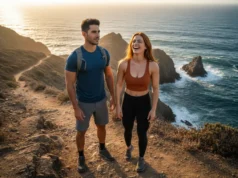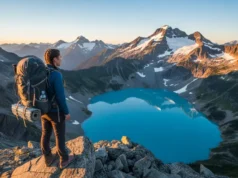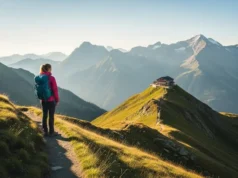In this article
Kaaterskill Falls is one of New York’s most captivating and popular waterfalls, but its beauty presents significant challenges on its recreational trails. The sheer volume of visitors creates difficult hurdles for parking, trail navigation, and personal safety. Instead of simple descriptions, you’ll find a complete strategic plan for your visit. It ensures you can confidently choose the right route for your skill level, find a legal parking spot, and hike the kaaterskill falls hiking trail safely.
This iconic Kaaterskill destination draws people in, but they often face the core problems of parking shortages, route confusion, and serious safety risks. This definitive, actionable plan solves these issues. You will learn a strategic approach to parking, a comparative guide to the three main routes to the waterfall, the non-negotiable safety rules, and expert tips for a better, more prepared hiking experience.
The Kaaterskill Falls At-a-Glance Trail Guide
Use this at-a-glance trail guide for a high-level overview of the most critical statistics for each hiking route. You can immediately understand the core differences in distance, difficulty, and topography before diving into the detailed trail descriptions. It is designed to provide instant answers to your most pressing questions about the hikes.
Kaaterskill Falls Hike Comparison Table
Access Routes to Kaaterskill Falls
Compare the different ways to reach the majestic Kaaterskill Falls and choose the best route for your adventure.
Terrain Description
Wide gravel path to the platform offering stunning views; a steep stone staircase leads to the base of the falls.
Best For
Families and first-time visitors looking for a more accessible yet rewarding experience.
Terrain Description
A rugged, natural trail with challenging terrain, including exposed rocks and roots.
Best For
Traditional hikers seeking a more challenging and immersive wilderness experience.
Terrain Description
Connects to the main trails leading to the falls, offering various terrain options. Requires a park entry fee.
Best For
A good backup plan or for visitors planning an all-day excursion within the park.
The table format directly addresses the need to compare options, a key piece of information often missing in other guides. To properly prepare for your first hike, use this table to assess which route best matches your current fitness and experience level.
The Kaaterskill Falls Parking Strategy: A 3-Tiered Plan
Finding a legal spot for kaaterskill falls hike parking is the first and often most significant challenge when visiting. A clear, actionable strategy eliminates parking anxiety and prevents the costly consequences of an illegal spot.
Parking Problem: The Reality of Crowds & Consequences
The core issue is straightforward: the designated lots are small and completely insufficient for the more than 200,000 annual visitors, especially on weekends and holidays. This discrepancy forces many to consider illegal parking along the narrow road of Route 23A, but law enforcement strictly enforces the “No Parking” zones. This results in frequent and expensive ticketing and towing, making a pre-planned strategy essential.
To prevent confusion, be aware that the Molly Smith parking area on Route 23A is permanently closed. State and local officials have implemented a suite of actions to protect public safety, and these parking restrictions are a key part of that effort. [1]
Your Action Plan: The 3-Tiered Parking Strategy
- Tier 1 (Primary Plan): Arrive early. On weekends, this means before 9 a.m. Target the two official lots first. The Laurel House Road Lot, the main trail head, is the closest and most convenient, but it is also the smallest and fills first. The Scutt Road Lot is larger and offers a better chance of finding a spot, though it adds a slightly longer, more traditional hike to your day.
- Tier 2 (Backup Plan): If the primary lots are full, your next move is to proceed to the North-South Lake Campground. This option requires paying a day-use fee, but it guarantees a parking spot and provides access to other amenities like restrooms and additional hiking trails in the wilderness.
- Tier 3 (Stress-Free Alternative): For any visit during peak season, strongly consider using the Kaaterskill Trolley. This service functions as a shuttle, picking up visitors from designated lots in nearby towns and dropping them directly at the trailhead. It is the most effective way to avoid parking-related stress entirely.
A Comparative Guide to the 3 Primary Hiking Routes
With your parking plan settled, it’s time to choose your trail. A detailed breakdown of the three primary routes to the falls empowers you to select the perfect path for your skill level, goals, and the parking spot you secured.
Route 1: Laurel House Road (The Main & Most Accessible Route)
This route offers two distinct experiences. The “easy” portion is a 0.6-mile round-trip short hike on a firm, wide gravel path with a gentle grade to the upper viewing platform. This makes it the best option to see the falls without a strenuous hike and is ideal for those needing an accessible, easy trail. These are great conditions to try out some basic tips for beginner hikers.
The “moderate” route continues from the platform to the base of the lower falls. This journey is a 1.4 to 1.8-mile round-trip from the parking lot, involving a significant 300-400 foot elevation change via a challenging stone staircase of over 400 steps. To navigate, follow the yellow trail markers to the platform, cross the footbridge, briefly follow the blue-blazed Escarpment Trail, and then take the yellow-marked Kaaterskill spur trail down the main staircase.
Route 2: Scutt Road (The Hiker’s Alternative)
This forest trail is the ideal choice for more traditional hikers or as the primary alternative when the Laurel House lot is inevitably full. The hike is a moderate 2.4 to 2.8-mile round-trip with a more significant elevation change of around 630 feet. This added effort makes it important to manage your energy on the trail, and good hiking boots are recommended.
The experience itself is a classic Catskills hike. The trail begins on the blue-marked Escarpment trail and follows a more rugged, natural path defined by rocks and roots through a wooded area. It eventually connects to the main trail system near the falls, offering a more immersive woodland experience before reaching the main attraction.
Route 3: Route 23A (The Historic & Now-Defunct Route)
CRITICAL SAFETY WARNING: The Molly Smith parking area on Route 23A is permanently closed. This is no longer a viable, legal, or safe access point for hiking to Kaaterskill Falls.
This route has a rich past as the original, historic trail to the falls. However, it required a dangerous walk along a high-traffic, shoulderless road, which led to its closure by the NYSDEC after numerous safety incidents. While you can still see Bastion Falls from the road near this defunct trailhead, you cannot and should not attempt to park or hike from this location.
The Kaaterskill Falls Safety System: Rules, Risks & Responsibility
The immense beauty of Kaaterskill Falls masks significant dangers that have resulted in numerous accidents and even fatalities. A proactive safety system, covering the official rules you must follow and the specific environmental ethics required, is essential for protecting yourself and this fragile place.
The Dangers: Understanding the Sobering Reality
The falls have a tragic history of accidents, which often occur when unwary hikers venture off-trail. The primary hazards are slipping on the notoriously slick wet or icy bluestone rock, falling from unstable cliffs edges, and being struck by falling ice or snow in the winter. Flash floods in the Clove also pose a serious risk.
It is crucial to understand that all the recent trail improvements—from the stone stairs to the viewing platform and fences—were specifically designed to mitigate these exact dangers and keep visitors on a safe hike. Preparing with a hiker’s emergency guide can help you appreciate the gravity of these risks.
Official NYSDEC Rules (Non-Negotiable for Your Safety)
The New York State Department of Environmental Conservation (NYSDEC) is the managing authority for this area. Following their rules is not optional; it is a requirement for your safety and the preservation of the forest. You can find the complete official regulations for the Kaaterskill Wild Forest on the DEC website.
- Stay on marked trails at all times. Do not climb around fences or barriers.
- Stay at least 6 feet from cliff edges. Unstable rock and slippery rocks make edges extremely hazardous.
- Swimming is prohibited within 150 feet of the top of the falls and is highly discouraged everywhere else due to the extreme danger of slick rocks and underwater hazards in the creek.
- The area is closed after sunset.
- The following are also prohibited: Glass containers, alcohol, campfires, and drones.
Your Kaaterskill Falls Safety Tool
Safety is non-negotiable. Use our interactive checklist to confirm your preparations, from checking trail conditions to packing essentials. You can even download a PDF copy for offline use.
Leave No Trace: A Kaaterskill Edition
Leave No Trace principles are especially critical in a high-traffic area like Kaaterskill Falls. This isn’t generic advice; it’s a specific set of ethics needed to protect this unique environment. You can learn more with a guide to Leave No Trace principles and explore the broader regulations applicable to the Catskill Park for more context.
- Pack It In, Pack It Out: This includes all food waste like fruit peels and pet waste. Leaving them behind habituates wildlife, including black bears, to human presence, which is dangerous for both animals and people.
- Travel on Durable Surfaces: Stay in the middle of the designated trail, even when it is muddy. Walking on the edges widens the path and causes severe erosion on the Clove’s steep, sensitive slopes.
- Be Considerate of Other Visitors: The trails are extremely crowded. Keep your voice low and do not play music from speakers. This allows everyone to enjoy the natural soundscape of the forest and the falls.
Pro-Tips for the Dedicated Hiker
Here, you’ll find advanced, targeted advice for our community of dedicated hikers. We cover expert techniques for tackling the terrain and provide guidance for specific scenarios like winter hiking, bringing a dog, and photography.
Expert Technique Workshop: Mastering the Stone Staircase
Mastering the staircase with expert techniques is a unique value-add for serious hikers, focusing on skills to improve your efficiency and reduce physical strain on the trail’s most demanding feature. These techniques are a form of tackling challenging terrain.
[PRO-TIP] The Rest Step (Ascending): To conquer the 400+ stairs on the way up, use the “rest step.” With each step, momentarily lock the knee of your back leg as your weight shifts to your front leg. This allows your skeletal system to bear the load, giving your muscles a micro-second of rest and conserving significant energy over the entire climb.
[PRO-TIP] The Perpendicular Step (Descending): Going down steep steps can be brutal on your knees. Instead of facing forward, turn your body to the side and descend by “side-stepping.” Using trekking poles here can further reduce impact and improve stability on the often slick, uneven stone.
Hiking Kaaterskill Falls in Winter
A winter visit offers a breathtaking reward: a massive, frozen waterfall, a transformed landscape, and a fraction of the summer crowds. However, this beauty comes with extreme challenges. The trails and stone stairways become covered in thick, treacherous ice, making the trekking incredibly dangerous without proper gear.
Traction devices are absolutely non-negotiable for a winter hike. Microspikes are the mandatory minimum for any attempt; full crampons and trekking poles are highly recommended for the added stability required to navigate the icy steps safely. Understanding the difference between Microspikes vs. Crampons is critical for your safety.
Hiking with a Dog & Photography Tips
- For Dog Owners: The official rule is that dogs are permitted but must be leashed at all times. Before you go, honestly assess if your dog can handle the extremely steep stone stairs and crowded conditions. The wet, slippery rocks are also a significant hazard for pets.
- For Photographers: For the best light and fewest crowds, visit on a weekday during the golden hours (early morning or late afternoon). A tripod is essential for achieving the classic “milky water” effect with a slow shutter speed. A circular polarizing filter is crucial for cutting the intense glare on wet rock, bringing out the natural color and detail. For more tips, check out our guide to backpacking with camera gear.
Deeper Context: The History & Geology of the Falls
To truly appreciate your hike, it helps to understand the deep history under your boots. Exploring the geological forces and rich cultural history reveals how Kaaterskill Falls transformed from a geological feature into an American icon in the Hudson Valley.
Geological Formation: From Ancient Seabed to Ice Age Icon
The story of the falls begins with the rock itself. The sandstone and shale layers that form the waterfall date back to the Devonian Period, approximately 385 million years ago, when the region was an ancient seabed. You can learn more about the specific details of the geological formation of the falls from the NYS Museum.
The falls we see today were carved much more recently, at the end of the last Ice Age. Immense glacial meltwater from the surrounding mountains carved the deep Kaaterskill Clove and created the iconic two-tiered drop, all fed by the waters of Kaaterskill Creek. While officially promoted as a 260-foot cascade, the more precise technical measurement is 231 feet from the top of the upper falls to the base of the lower falls.
Cultural History: The Hudson River School & The Birth of Tourism
Long before European arrival, the falls were a sacred site for the indigenous Mohican people, who considered the area a resting place of the creator. The pivotal moment in American art history came in 1825 with the visit of painter Thomas Cole. His work launched the Hudson River School art movement, which celebrated the American wilderness and turned Kaaterskill Falls into a national symbol.
This fame cemented the falls’ place in the American imagination and kicked off a tourism boom. The subsequent “Grand Hotel Era” saw the construction of massive hotels like the Laurel House. In a stunning display of commercial control, the hotel famously built a dam at the top of the falls, holding the water back and then “turning on” the waterfall for paying guests below. These stories of resilience and self-discovery echo the historical human connection to these powerful places.
Conclusion: Your Confident Kaaterskill Falls Adventure Awaits
Hiking Kaaterskill Falls is a deeply rewarding experience when you arrive properly prepared. The key to a successful and enjoyable day hike is having a strategic plan for parking and choosing the right route for your abilities. Safety is paramount; the official NYSDEC rules are non-negotiable and were created specifically to protect you from the trail’s real dangers. By understanding the trail options, planning ahead, and respecting the regulations, you can move beyond the stress of the crowds and confusion to truly enjoy this iconic Catskills landscape.
After your hike, share your experience or any updated trail tips in the comments below to help our community of fellow hikers!
Frequently Asked Questions about Hiking Kaaterskill Falls
How long is the hike to Kaaterskill Falls?
The length depends entirely on your chosen route. The easiest walk from the Laurel House lot to the upper viewing platform is a 0.6-mile round trip. The most common hike from there to the base of the falls and back is about 1.4 to 1.8 miles.
Can you see Kaaterskill Falls without hiking?
Yes. The main upper viewing platform offers a spectacular view of both tiers of the waterfall and is accessible via a short, 0.3-mile walk on a wide, packed gravel path from the Laurel House Road parking area. This is a great option for those with limited mobility.
Is the hike to Kaaterskill Falls difficult?
The walk to the viewing platform is easy. However, the full hike to the base of the falls is considered moderate. This is due to the steep descent and strenuous ascent on a stone staircase of over 400 steps, which can be very challenging on the climb back up.
Can you swim at Kaaterskill Falls?
No. Swimming is officially prohibited by the NYSDEC within 150 feet of the top of the falls. It is strongly discouraged everywhere else due to extreme dangers, including incredibly slippery rocks, cold water temperatures, and unseen underwater hazards that have led to serious accidents.
Risk Disclaimer: Hiking, trekking, backpacking, and all related outdoor activities involve inherent risks which may result in serious injury, illness, or death. The information provided on The Hiking Tribe is for educational and informational purposes only. While we strive for accuracy, information on trails, gear, techniques, and safety is not a substitute for your own best judgment and thorough preparation. Trail conditions, weather, and other environmental factors change rapidly and may differ from what is described on this site. Always check with official sources like park services for the most current alerts and conditions. Never undertake a hike beyond your abilities and always be prepared for the unexpected. By using this website, you agree that you are solely responsible for your own safety. Any reliance you place on our content is strictly at your own risk, and you assume all liability for your actions and decisions in the outdoors. The Hiking Tribe and its authors will not be held liable for any injury, damage, or loss sustained in connection with the use of the information herein.
Affiliate Disclosure: We are a participant in the Amazon Services LLC Associates Program, an affiliate advertising program designed to provide a means for us to earn advertising fees by advertising and linking to Amazon.com. As an Amazon Associate, we earn from qualifying purchases. We also participate in other affiliate programs and may receive a commission on products purchased through our links, at no extra cost to you. Additional terms are found in the terms of service.





